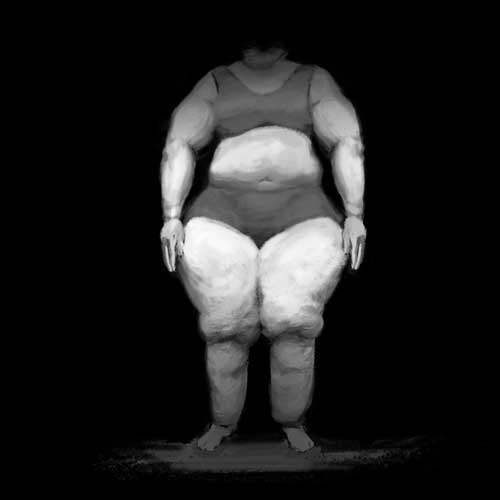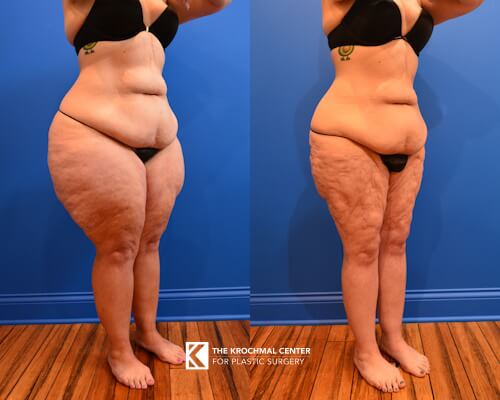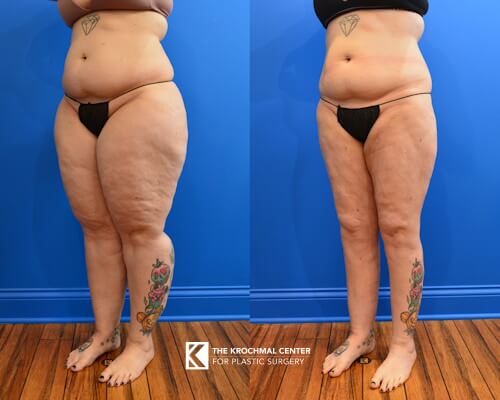At The Krochmal Center for Plastic Surgery

Watch Dr. Daniel Krochmal, MD, FACS talk about types of Liposuction at The Krochmal Center for Plastic Surgery.
Dr. Daniel Krochmal, MD, FACS answers your most common questions about WipoLipo™ Liposuction for Lipedema
WipoLipo™ is short for “wipe-out liposuction”. It’s a technique used for patients with lipedema to remove as much of the fat as possible in any given surgery. For more info, check out Dr. Krochmal’s talk at the 2019 Fat Disorders Resource Society Meeting: WATCH HERE.
WipoLipo™ is done by performing thorough Liposuction on an area of the body affected by the diseased fat in lipedema. Typically the “end-points” for Liposuction are 1) there is no more fat to remove, or 2) the experienced surgeon feels that it may be unsafe to continue (for instance, if the fat being removed becomes too bloody to safely continue).
The procedure is done under general anesthesia for maximum patient comfort. Tumescent fluid with lidocaine and epinephrine is infiltrated into the areas where Liposuction will be performed. The lidocaine helps to limit the amount of general anesthesia used, and the epinephrine constricts the blood vessels so they aren’t as easily injured (meaning you’ll have less bleeding and bruising). Then, very thorough Liposuction is performed on the area using either regular liposuction or PAL (power-assisted liposuction). Many times there is “Dueling Liposuction” performed, meaning there is Liposuction being performed on each extremity simultaneously. “Dueling Liposuction” allows for shorter anesthesia times, and allows for the compression garment to be put on IMMEDIATELY after doing Liposuction to an extremity (vs. waiting for the other side to be done, which would cause more oozing and leaking of fluid in the first extremity).
A good candidate for WipoLipo™ is a patient with lipedema that wants the fat in an area of the body GONE. Patients may already have mobility issues, or may be at risk for mobility issues in the future because of their lipedema progression. Prior to surgery for WipoLipo™, it’s best to have your veins checked for venous insufficiency (and have your veins ablated) to reduce bleeding and swelling during the procedure. There is not an absolute “cut-off BMI”, but it’s still important to stay healthy, by eating healthy low-inflammatory foods, and also to work out. Working out helps to keep the “non-lipedema” fat down which improves your heart and lung function to help your recovery. If you have diabetes, you’ll want to get that under tight control with the help of your doctor.
WipoLipo™ is performed in a hospital setting due to the extensive monitoring of fluid status that must occur after this procedure. Patients typically spend 1-2 nights in the hospital. A urinary catheter is used for the first night as this helps with fluid monitoring. When you’re ambulating and voiding without difficulty you’ll be ready to go home. Most patients report the pain level to be very tolerable, and we’ll control your discomfort with pain medication. The compression garment for the lower extremities is typically a velcro “crisscross” garment as this is far more adjustable than a standard “pull-up” compression garment. Your extremities will shift remarkably in size as the swelling goes up and down, so it’s best to have something that’s highly adjustable versus buying many compression garments.
You may feel a bit tired and “worn out” for the first week as your body gets used to what happened, but we’ll follow you closely and provide that helping hand. In general, you can shower after several days (we want to keep the compression garment on at all times for at least 3 days), and light walking to do your regular activities is encouraged. However, we ask that you avoid soaking in water, heavy lifting, more strenuous physical activity, and massage/MLD for at least 1 month while your tissues heal properly.
Dr. Krochmal gets that question a lot. The lymphatics are very important to your body’s function, but Dr. Krochmal has not seen any of his patients develop lymphedema from Liposuction for lipedema, despite his very thorough Liposuction techniques and aggressive removal of the firm nodules under the skin. The lymphatics are highly redundant, and are more resilient than many practitioners think. Plus, the important ones are very deep to where liposuction is performed, so injuring them is highly unlikely even with the most intensive liposuction in the proper locations. For a long while, there was a school of thought that you had to treat the lymphatics with “kid gloves”, however that’s not necessary with the latest Liposuction techniques.
Check out their before/after pictures to get a sense of their technical and artistic style, and see if they operate on patients that appear similar to you. And most importantly, schedule a consultation with that doctor to see if they are a good “fit” for you.
Every doctor has his or her own personality and approach to patient care, so you will want to see if you like that particular approach. Do they inspire confidence and trust? Are they calming and reassuring? Do they take the time to answer your questions? Do they discuss alternative approaches and say why those approaches may or may not work? Do they seem like they will continue to care for you after the procedure?
There is no “best Liposuction surgeon”, but there is a “best” surgeon for you. You just may need to consult with several to find the right one. Hopefully Dr. Krochmal is on your list of Chicago plastic surgeons to see. We’re happy to help shape your future!
The price of WipoLipo™ Liposuction procedures ranges from $15,000 – $35,000.
Removal of fat with WipoLipo™ Liposuction is permanent. Any remaining fat may continue to grow, but since the vast majority of diseased fat was removed, your result should always be better than if you never had the procedure.
You should get WipoLipo™ Liposuction if you have a diagnosis of Lipedema and desire to have the diseased fat significantly reduced to improve your current (and future) ability to function.
Dr. Daniel Krochmal, MD, FACS shares real patient results from WipoLipo™ Liposuction at The Krochmal Center for Plastic Surgery.

44 yo Female with Lipedema. Following WipoLipo™ liposuction to her buttocks, thighs, and lower legs. 25.1 pounds were removed in 1 surgery.

38 yo Female with Lipedema. Following WipoLipo(TM) liposuction to her buttocks, thighs, and lower legs (and arms). 46.8 pounds were removed in 1 surgery (no, that’s not a typo).